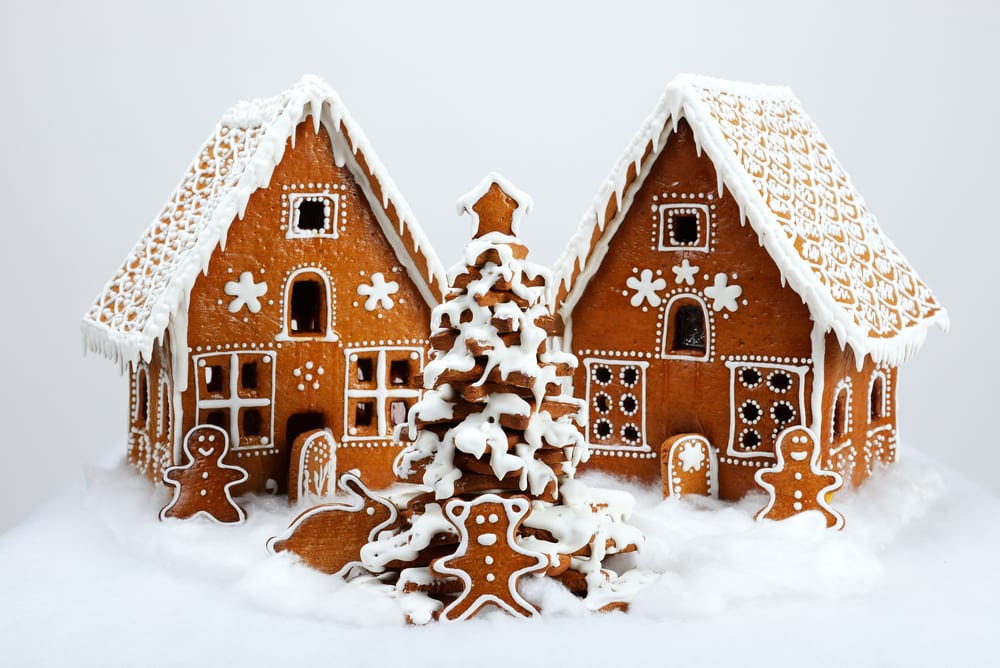The art of the gingerbread house
The art of the gingerbread house
The art of the gingerbread house
-
Hannah
-
Hannah

Knusper, knusper, knäuschen,
wer knuspert an meinem Häuschen?
Nibble, nibble, gnaw
Who is nibbling at my little house?
So says the witch in the children’s fairy-tale ‘Hansel and Gretel’ by the Brothers Grimm.
I loved fairy-tales growing up, but I always found this one quite dark and chilling. However, like most children, I was completely enamoured with the idea of an edible house made from gingerbread and decorated with sweets!
There is something intrinsically Christmassy about a gingerbread house to me: it’s fanciful, it’s joyful, and it’s decadently spicy and sweet. At what other time of year would one take the time to make a work of art out of sweet foodstuffs, present it proudly for visitors to admire and then (I hope) eat it?
Historically, gingerbread wasn’t related to Christmas at first. It originated in Europe in the 11th century, inspired by spiced bread from the Middle East. Once recipes were perfected, attention turned to presentation – it was realised that the dough could be formed into many different shapes and then decorated.
Queen Elizabeth I pioneered gingerbread men when she commanded her cooks to shape gingerbread into the likenesses of visiting dignitaries. But it was Germany that became the epicentre of gingerbread development, and come the 1600s a guild had been formed in Nuremburg for which master craftsmen began creating works of art from gingerbread, everything from animals to reliefs of saints, from window decorations to talismans to wear in battle. The art of gingerbread was taken so seriously that you were only allowed to make gingerbread if you were a professional artisan other than at Christmas and Easter – which is likely how the Christmas association began.
We have the Grimm brothers to thank for the development of the gingerbread house. Inspired by the hexenhaus (witch’s house) of ‘Hansel and Gretel’, bakers added small houses to their ranges, which proved popular in Germany and then in other countries when travellers and immigrants shared the tradition.
Today, many people make gingerbread houses in the lead-up to Christmas, and the art of the gingerbread house is taken seriously the world over. In Bergen, Norway, for example you can visit the annual Pepperkakebyen (gingerbread village), which is like a model village but entirely made of gingerbread, and in Toruń, Poland, you can visit the Muzeum Piernika, a museum devoted to gingerbread. In the US, meanwhile, you can celebrate ‘National Gingerbread House Day’ on 12th December and take part in one of many good-natured contest to make the best, more creative or biggest house (the biggest so far was made in Texas in 2013; it was 234 metres square and contained no less than 1,327 kilograms of sugar).
Personally, when it comes to gingerbread houses I prefer miniature to giant. Here’s my tried-and-trusted recipe, which has been the basis of many gingerbread treats over the years:
350g plain flour
1 tsp bicarbonate of soda
2 tsp ground ginger
1 tsp ground cinnamon
125g butter
175g light brown sugar
1 egg
4 tbsp golden syrup
1. Melt the butter over a low heat.
2. Add the golden syrup and sugar, remove from heat and stir until dissolved.
3. Mix into the other ingredients.
4. Form in a dough, cover and refrigerate for 15 minutes.
5. Roll out and shape/cut as desired.
6. Bake at 180 degrees for 10 to 15 minutes (depending on thickness) until golden and just firm to the touch.
7. Cool, decorate – enjoy!